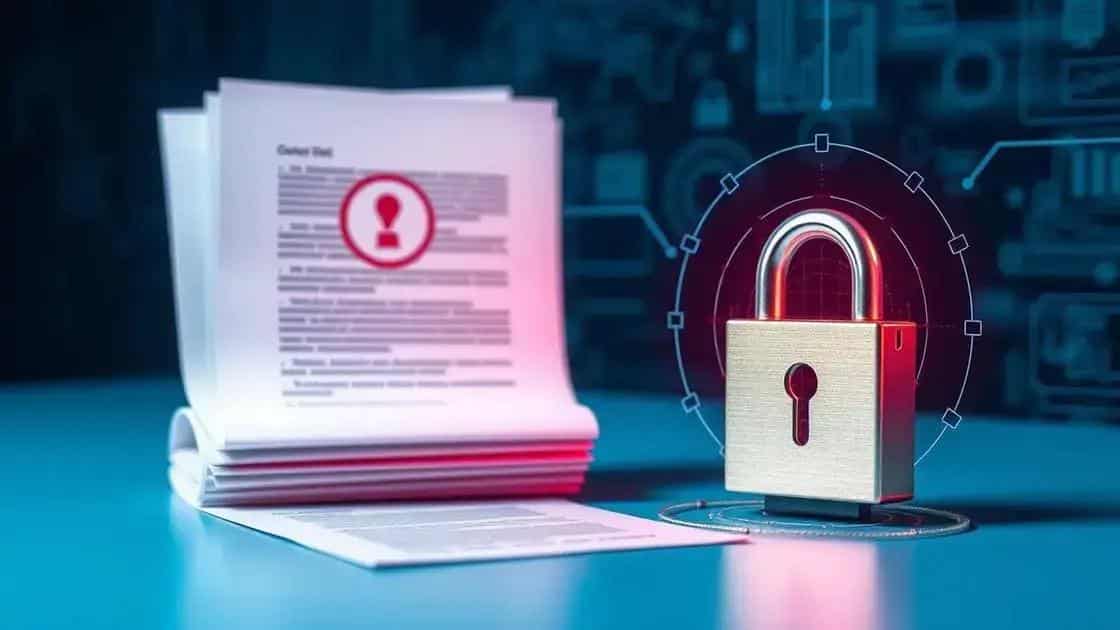Data leaks from intelligence agencies: what you need to know

Data leaks from intelligence agencies pose significant risks to national security and privacy, necessitating robust protective measures, employee training, and the implementation of advanced technologies to mitigate these threats.
Data leaks from intelligence agencies have become significant concerns in our digital age. With data breaches making headlines, it’s essential to understand their implications and what we can do to safeguard our information.
Understanding the nature of data leaks
Understanding the nature of data leaks is crucial in today’s cyber landscape. These incidents often stem from various sources and can have severe consequences for individuals and organizations alike.
One primary cause of data leaks is negligence in handling sensitive information. For instance, employees may inadvertently disclose confidential data through unsecured emails or mistakenly share files with unauthorized personnel. Such actions can lead to unintended access by malicious actors.
Types of Data Leaks
Data leaks can be categorized into several types, each impacting security differently. Understanding these types helps in formulating better preventive measures.
- Insider leaks: These occur when individuals within an organization share confidential information intentionally or unintentionally.
- Hacking incidents: Cybercriminals often target organizations to steal sensitive data through various hacking techniques.
- Physical loss: This happens when devices containing sensitive information are lost or stolen.
- Third-party vendor exposure: Data might be compromised when sharing information with external service providers.
Moreover, technology plays a significant role in either facilitating or preventing data leaks. With the rise of cloud storage and remote work, it is essential for companies to implement strict data security measures. Organizations should ensure that all employees are trained on data protection protocols to minimize the risk of leaks.
Encryption is a powerful tool in safeguarding sensitive data stored digitally. By encrypting data, organizations can significantly reduce the chances of information being useful to unauthorized users in the event of a breach. Regular audits to assess data security measures can help in identifying vulnerabilities early on.
Investing in robust cybersecurity systems also safeguards against potential threats. Firewall, antivirus software, and regular updates are vital components in creating a secure environment where data leaks are less likely to occur. As technology continues to evolve, staying informed about developments in cybersecurity is more important than ever.
In summary, understanding the nature of data leaks involves recognizing the various causes and types of leaks, as well as the technological measures that can be implemented to protect sensitive information. This knowledge empowers individuals and organizations to take proactive steps in safeguarding their data.
High-profile cases of data leaks
High-profile cases of data leaks have shocked the world in recent years. These incidents reveal how vulnerable even large organizations can be to security breaches.
One notable case involves a major social media platform. In this incident, hackers gained access to millions of personal records. The leak exposed sensitive information, including email addresses and phone numbers, causing a public outcry over privacy violations. Such breaches highlight the importance of robust security measures.
Other Significant Incidents
Additionally, another case involved the leak of classified military documents. These documents provided insight into operational strategies and sensitive information. The repercussions were significant, impacting national security and raising concerns about the safety of personnel involved.
- Equifax data breach: This incident exposed the personal data of over 147 million people. Names, Social Security numbers, and credit card details were compromised.
- Yahoo data breaches: Yahoo faced several breaches that affected over 3 billion user accounts, showcasing how attacks can happen over time.
- Wikileaks: This platform has published a substantial number of classified documents from various governments, highlighting vulnerabilities in state security.
- Panama Papers: The leak of these documents exposed many high-profile individuals involved in tax avoidance schemes worldwide.
These cases reveal the vast impact of data leaks. They stress the need for organizations to enhance their cybersecurity strategies. Even with technical measures in place, employee training is crucial to minimize human error.
Moreover, the public’s trust hinges on how organizations respond to such leaks. Transparency and accountability can lead to better relationships with users. When data breaches occur, prompt notification and clear communication are paramount to maintaining trust.
Impact on national security and privacy

The impact of data leaks on national security and privacy is profound. Every time sensitive information is compromised, it raises serious concerns about the safety and privacy of individuals and nations.
National security is often jeopardized when critical data falls into the wrong hands. For instance, if classified information about military operations is leaked, it could endanger the lives of service members and compromise missions. This exposure can lead to strategic disadvantages and potentially harm national interests.
Privacy Violations
On a personal level, data leaks can lead to severe privacy violations. When personal data, such as Social Security numbers, banking details, or medical records, is exposed, it can result in identity theft and financial loss. Victims may find themselves dealing with the aftermath of fraud, along with the stress that comes with it.
- Increased risk of identity theft: Exposed data can be used by criminals to assume someone’s identity.
- Financial implications: Victims may face costly consequences to recover their identities or finances.
- Emotional stress: The loss of privacy can lead to anxiety and a feeling of vulnerability among individuals.
- Violation of trust: Organizations that experience data breaches can lose the trust of their customers.
Moreover, government entities face significant challenges when addressing data leaks. There is a constant need to enhance security protocols to protect sensitive information. However, as technology evolves, so do the methods that attackers use to exploit vulnerabilities. Therefore, it is essential for national authorities to stay vigilant and proactive.
Lawmakers also play a crucial role in establishing regulations to protect data privacy. Creating laws that require organizations to notify individuals promptly after a data breach can help mitigate the effects of these incidents. Awareness campaigns about data protection can empower citizens to take steps in securing their information, ultimately reducing risks.
Preventive measures agencies can take
Preventive measures agencies can take to safeguard against data leaks are crucial for maintaining security and trust. Implementing these strategies can help minimize risks and protect sensitive information.
One effective approach is to provide regular training to employees about data security. When staff are aware of the potential dangers of data leaks, they are better equipped to follow best practices. This training should cover topics like phishing attacks, password management, and safe data handling procedures.
Establishing Strong Security Protocols
Agencies can also establish strong security protocols to enhance their defenses. These protocols should include:
- Data encryption: Encrypting sensitive information ensures that even if it is intercepted, the data remains unreadable.
- Access controls: Limiting access to sensitive information only to those who need it reduces the chances of internal leaks.
- Regular audits: Conducting audits helps identify vulnerabilities in security systems and data management practices.
- Incident response plans: Having a plan in place for responding to data breaches ensures that agencies can react quickly and effectively.
Another critical step is adopting advanced technologies to monitor and detect suspicious activities. Tools like intrusion detection systems can alert agencies to potential threats before they become major problems. Additionally, leveraging artificial intelligence can help predict and prevent future breaches by analyzing patterns in data access.
Furthermore, agencies should work closely with cybersecurity experts to stay updated on the latest threats and mitigation strategies. Collaborating with external specialists can provide a fresh perspective on existing practices and highlight areas for improvement.
Continuous improvement in security measures is essential as cyber threats evolve. Regularly updating software and systems is vital to ensure protection against the latest vulnerabilities. This proactive approach can significantly reduce the likelihood of falling victim to data leaks.
The role of technology in protecting data
The role of technology in protecting data is vital in today’s digital landscape. As threats evolve, technology continually adapts to provide better security measures against data leaks.
One significant advancement is the use of encryption. By encrypting sensitive data, organizations ensure that even if unauthorized users gain access, they cannot read the information without the proper decryption key. This is especially important for data at rest and data in transit, which can be vulnerable to interception.
Emerging Technologies in Data Protection
Technologies such as artificial intelligence (AI) and machine learning play essential roles in data protection strategies. These technologies enable organizations to analyze vast amounts of data quickly, identifying unusual patterns or potential threats. Early detection of anomalies can help prevent breaches before they escalate.
- Automated threat detection: AI systems can monitor networks for unusual activity, improving response times and minimizing damage.
- Data loss prevention (DLP) solutions: DLP tools track and control data transfer to help prevent accidental data leaks.
- Cloud security measures: As businesses increasingly rely on cloud storage, robust security features such as multi-factor authentication and secure access controls become indispensable.
- Blockchain technology: This technology offers secure transaction methods that are transparent and tamper-proof, enhancing data integrity.
Moreover, biometric security measures have gained popularity as an effective way to safeguard access to sensitive data. By using characteristics like fingerprints or facial recognition, organizations can ensure that only authorized individuals access critical systems.
It’s also essential for organizations to regularly update their software and security protocols. Cyber threats continuously evolve, and by keeping systems updated, organizations can better defend against new vulnerabilities. Regular updates often include patches for known security issues and improvements to existing technologies.
Organizations should also consider employing third-party security experts who specialize in identifying vulnerabilities and recommending tailored solutions. Collaborating with experts ensures a comprehensive approach to protecting data efficiently and effectively.
FAQ – Common Questions about Data Protection and Security
What are data leaks and why are they concerning?
Data leaks are unauthorized disclosures of sensitive information. They are concerning because they can lead to identity theft, financial loss, and compromise national security.
How can organizations prevent data leaks?
Organizations can prevent data leaks by implementing strong security protocols, training employees, and using advanced technologies like encryption and AI for monitoring.
What role does employee training play in data protection?
Employee training is essential as it educates staff about the importance of data security and helps them recognize potential threats like phishing.
Why is it important to update software regularly?
Regularly updating software is crucial to protect against new vulnerabilities and ensure that all security features are effective in guarding against potential breaches.






